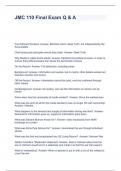-
1. Exam (elaborations) - Lewis chapter 32: hypertension/medical-surgical nursing, 10th edition questions and c...
-
2. Exam (elaborations) - Chapter 28: obstructive pulmonary diseases lewis: medical-surgical nursing, 10th edit...
-
3. Exam (elaborations) - Med/surg final (lewis chapters 14-16, 23-24, 41-50, 63-65) questions and correct deta...
-
4. Exam (elaborations) - Chapter 63: musculoskeletal problems lewis: medical-surgical nursing, 10th edition qu...
-
5. Exam (elaborations) - Medical surgical nursing lewis chapter 1 - professional nursing practice questions an...
-
6. Exam (elaborations) - Chapter 48: diabetes mellitus lewis: medical-surgical nursing, 10th edition questions...
-
7. Exam (elaborations) - Lewis ch 1 : professional nursing questions and correct detailed answers with rationa...
-
8. Exam (elaborations) - Lewis medical surgical nursing: chap 46 upper gi problems questions and correct detai...
-
9. Exam (elaborations) - Chapter 57: stroke lewis: medical-surgical nursing, 10th edition questions and correc...
-
10. Exam (elaborations) - Chapter 19: postoperative care lewis: medical-surgical nursing, 10th edition question...
-
11. Exam (elaborations) - Lewis medical surgical nursing chap 50: renal and urologic problems questions and cor...
-
12. Exam (elaborations) - Chapter 64: arthritis and connective tissue diseases lewis: medical-surgical nursing,...
-
13. Exam (elaborations) - Chapter 60: nursing management: stroke lewis et al.: medical-surgical nursing in cana...
-
14. Exam (elaborations) - Chapter 10: pain lewis et al.: medical-surgical nursing in canada, 3rd edition questi...
-
15. Exam (elaborations) - Chapter 50: assessment of reproductive system lewis: medical-surgical nursing, 10th e...
-
16. Exam (elaborations) - Lewis - chapter 24: burns questions and correct detailed answers with rationales 2025...
-
17. Exam (elaborations) - Chapter 25: assessment of respiratory system lewis: medical-surgical nursing, 10th ed...
-
18. Exam (elaborations) - Chapter 20: nursing management: preoperative care lewis et al.: medical-surgical nurs...
-
19. Exam (elaborations) - Chapter 25: assessment of respiratory system lewis: medical-surgical nursing, 10th ed...
-
20. Exam (elaborations) - Chapter 37: vascular disorders lewis: medical-surgical nursing, 10th edition question...
-
21. Exam (elaborations) - Lewis: medical-surgical nursing~chapter 17 questions and correct detailed answers wi...
-
22. Exam (elaborations) - Chapter 27: lower respiratory problems lewis: medical-surgical nursing, 10th edition ...
-
23. Exam (elaborations) - Lewis - med-surg nursing - study guide - ch. 11 questions and correct detailed answer...
-
24. Exam (elaborations) - Lewis - med-surg nursing - study guide - ch. 11 questions and correct detailed answer...
-
25. Exam (elaborations) - Chapter 49: endocrine problems lewis: medical-surgical nursing, 10th edition question...
-
26. Exam (elaborations) - Chapter 60: spinal cord and peripheral nerve problems lewis: medical-surgical nursing...
-
27. Exam (elaborations) - Chapter 30: nursing management: lower respiratory problems lewis et al.: medical-surg...
-
28. Exam (elaborations) - Lewis med-surg ch. 33 cad and acute coronary syndrome questions and correct detailed ...
-
29. Exam (elaborations) - Med-surg - chapter 10: pain (lewis) questions and correct detailed answers with ratio...
-
30. Exam (elaborations) - Lewis ch. 2 questions and correct detailed answers with rationales 2025/2026 (verifie...
-
31. Exam (elaborations) - Chapter 55: assessment of nervous system lewis: medical-surgical nursing, 10th editio...
-
32. Exam (elaborations) - Lewis medical surgical --chapter 53 diabetes questions and correct detailed answers w...
-
33. Exam (elaborations) - Chapter 44: nursing management: upper gastrointestinal problems lewis et al.: medical...
-
34. Exam (elaborations) - Chapter 16: fluid, electrolyte, and acid-base imbalances lewis: medical-surgical nurs...
-
35. Exam (elaborations) - Chapter 68: emergency and disaster nursing lewis: medical-surgical nursing, 10th edit...
-
36. Exam (elaborations) - Chapter 56: acute intracranial problems lewis: medical-surgical nursing, 10th edition...
-
37. Exam (elaborations) - Lewis medical surgical chap 66: assessment, musculoskeletal system questions and corr...
-
38. Exam (elaborations) - Lewis ch. 17 - preoperative care questions and correct detailed answers with rational...
-
39. Exam (elaborations) - Lewis: med-surg: chapter 16: cancer questions and correct detailed answers with ratio...
-
40. Exam (elaborations) - Chapter 20: assessment of visual and auditory systems lewis: medical-surgical nursing...
-
41. Exam (elaborations) - Medical-surgical nursing lewis chapter 16 questions and correct detailed answers with...
-
42. Exam (elaborations) - Lewis chapter 17: fluid, electrolyte, and acid-base imbalances, lewis med-surg ch 17,...
-
Show more





